|
|

|
|
|
The Journey of a Thousand Miles
|
[2008 was the 50th Anniversary of the Legion of Super-Heroes, and as the author of two books about the Legion (2003's The Legion Companion and 2004's The Best of The Legion Outpost), I wrote the following essay about the publication history of The Legion of Super-Heroes for the 2008 Comic-Con International Souvenir Book. It covered the period both before the Legion received its own title and the decades since, and left off just before the Final Crisis: Legion of Three Worlds mini-series was published. Chronologically, this is when Paul Levitz had yet to return to the Legion for his third stint with the characters, and Jim Shooter was still writing the Three-Boot Legion in their own monthly series. The future, at that point, was still unwritten.]
|
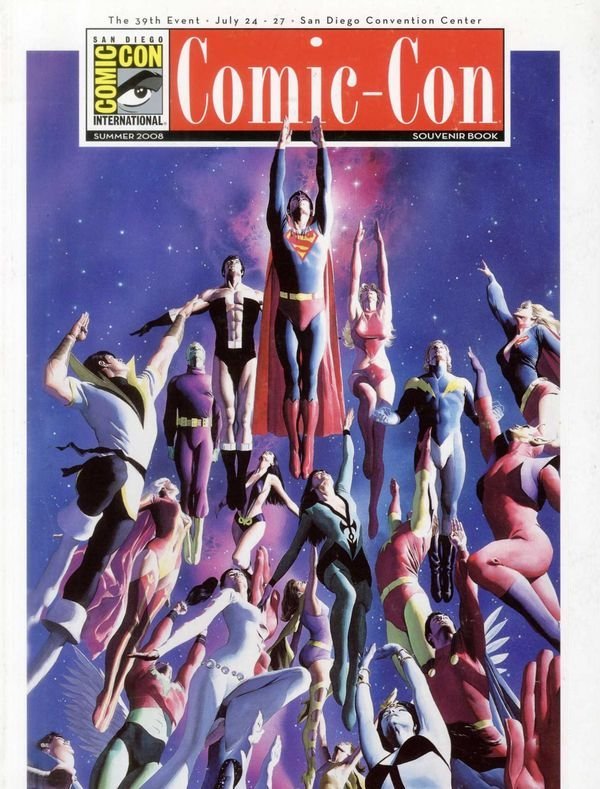
The cover of the Comic-Con International Souvenir Book for 2008, taken from Alex Ross' Legion of Super-Heroes print. Legion of Super-Heroes TM © DC Comics.
|
|
It began as a simple idea: three teenagers from the future would travel back in time to ask a young Clark Kent to join their super-hero club. No sequel was planned; it was only ever intended to be the latest in a long line of one-shot Superboy tales. In the previous issue of Adventure Comics, Lang Lang tried to determine Superboy's true identity. In the following issue, Superboy underwent, "The Great Super-Powers Contest!" In between, in Adventure Comics # 247 (cover-dated April, 1958; actual on-sale date February 27th), the Legion of Super-Heroes was born.
As the legend goes, by the time sales reports came in, letters had already arrived asking for more Legion of Super-Heroes stories. So another story was ordered, and another, and eventually the Legion was given the back-up feature in Adventure Comics, starting with # 300 (cover-dated September, 1962). In time, the teens from the future graduated into the lead, and then they took over the book entirely.
|
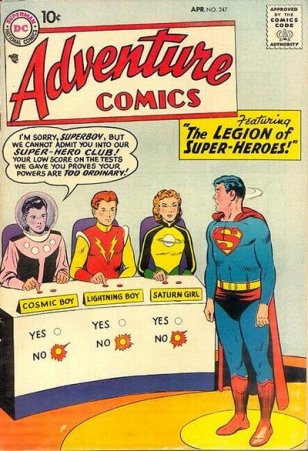 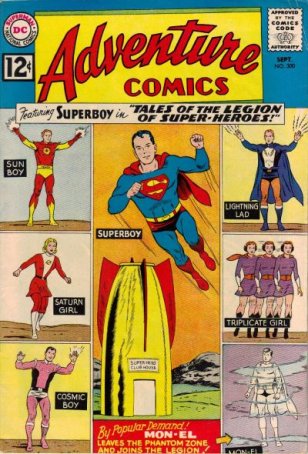
| | |
Where it all began! On the left, the Legion's first appearance in Adventure Comics # 247, and when they started as a regular feature in Adventure Comics with # 300. Both covers are illustrated by Curt Swan. © DC Comics.
|
|
The Legion enjoyed a long run in Adventure Comics, where they stayed until 1969, at which point they were unceremoniously removed from the series and demoted to the back-up feature in Action Comics. The decision had no bearing on the Legion's performance in Adventure; instead, as legend once again informs us, Superman family editor Mort Weisinger was given an order to give Supergirl her own comic book. Weisinger, however, was dissatisfied with his employ at DC and knew that his days there were drawing to a close. Rather than add another title to his workload, he pulled a switch: Supergirl got the lead in Adventure, and the Legion got Supergirl's former home in the back of Action. The trade was ultimately a disaster, with Adventure's sales plummeting and Action's continuing a slow decline.
When Weisinger stepped down in 1970, his titles were given to two editors: Julie Schwartz and Murray Boltinoff. Schwartz got Superman and Adventure, while Boltinoff got Superboy and Action. Right away, the Legion stopped appearing in Action, replaced by more Superman stories. In reality, Boltinoff just didn't get the feature. When he did give consideration to the Legion, he decided that it was a more appropriate fit for Superboy, and so periodically Legion back-ups appeared in that title. The Legion was in dire straits, and its best days looked to be in its past.
|
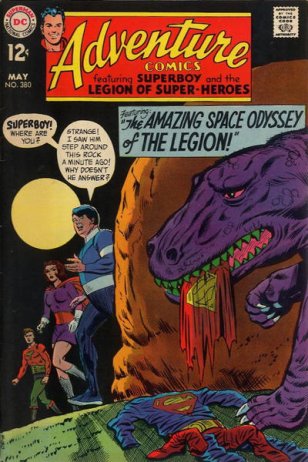 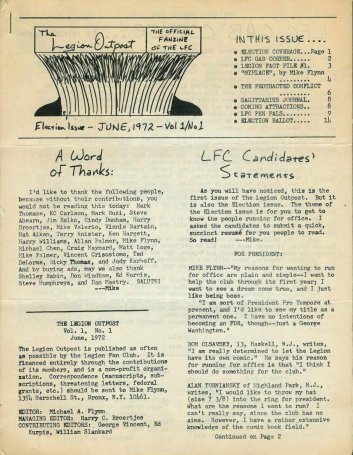
|
|
On the left, the last appearance of the Legion of Super-Heroes in Adventure Comics (# 380, cover-dated May, 1969). On the right, the first issue of The Legion Outpost fanzine from June, 1972. Adventure Comics © DC Comics; TLO © Mike Flynn & Harry Broertjes.
|
|
|
This is where organized Legion fandom enters the picture. The Legion Fan Club was founded by thirteen-year-old Mike Flynn in 1972 with the sole purpose of returning the Legion to its former glory. With an army of about two hundred, the LFC served Boltinoff with notice that the Legion's current predicament would not do, and they wrote letters to that effect. Flynn even started a newsletter called The Legion Outpost which later morphed into a fanzine which stood shoulder to shoulder with any other fan-based publication of its day. The Legion fans were both adamant and militant; what's more, they were successful. Even though, as Boltinoff once confessed, sales on issues of Superboy with the Legion showed no appreciable difference to those without, all of the ruckus got his attention, and he was impressed. After all, no other DC feature got that kind of notice, and he had the letters to prove it.
So the Legion's frequency in Superboy increased, and it even got its own short-lived, self-titled reprint series as part of DC's revival of neglected properties at the same time. That book lasted all of four issues, and since Boltinoff saw it as stealing sales from Superboy, when the decision was made to tell longer Legion stories, it was decided that they would be in the front of Superboy, rather than in their own book. For Legion fans, it was cause for celebration: with its 197th issue, Superboy's logo was changed to that of Superboy starring the Legion of Super-Heroes.
|
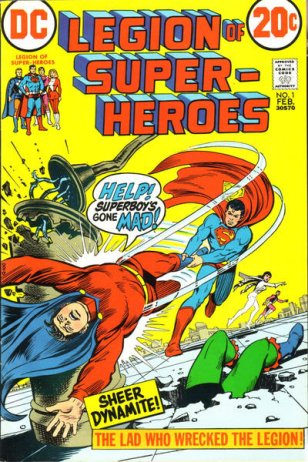 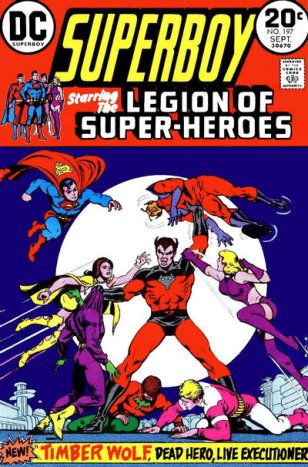
|
|
The first time the Legion of Super-Heroes received their own title, it was a reprint series. After wandering in the wilderness for three years, the Legion returned to cover status in new adventures in Superboy # 197, cover-dated September, 1973). © DC Comics.
|
|
|
In time, Superboy left the Legion, and for the second time he was replaced in his own series by his teammates. Superboy starring the Legion of Super-Heroes became just The Legion of Super-Heroes, but by that point, the feature was more than just a fan favorite: it was also a commercial success. Work by pros such as Dave Cockrum, Mike Grell, Jim Shooter, Paul Levitz, and Jim Sherman had elevated the Legion to best-seller status, where it remained for most of the decade.
With the advent of the 1980s, the Legion had real competition. That same year, Marv Wolfman and George Perez launched DC's new number one title, The New Teen Titans, and the Legion had to settle for the number two spot. But it wasn't all gloom and doom: Paul Levitz and Keith Giffen gave the world "The Great Darkness Saga," which has been hailed since by just about everyone who's ever read a Legion comic as the greatest Legion story ever. According to Wolfman, the Legion of that era outsold the rest of the DC line (minus the Titans) by a factor of two to one, and according to Levitz, during his and Giffen's inaugural year on the series, sales jumped by over fifty thousand units. That's a lot of comic books.
|
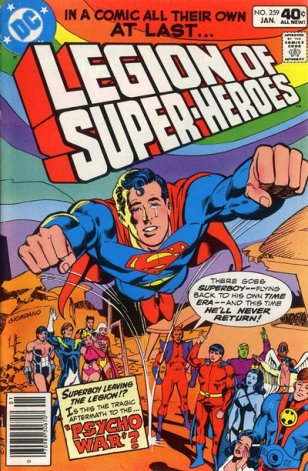 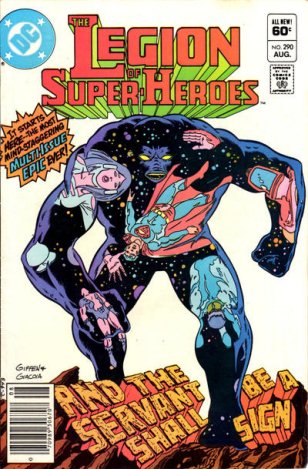
|
|
Superboy says good-bye to the Legion in # 259 (cover-dated January, 1980), but was back as a guest-star for "The Great Darkness Saga," which began in LSH # 290 (cover-dated August, 1982). © DC Comics.
|
|
|
In 1984, DC began an experiment which ultimately removed both The New Teen Titans and The Legion of Super-Heroes from the newsstand market. Both books suffered competitively as a result; then, in 1989, after nine-and-a-half years spread over two runs on the title, Paul Levitz decided to step down as author of The Legion of Super-Heroes. In order to distance himself from his predecessor's run, the new Legion plotter/artist Keith Giffen set the series "Five Years Later," with a decidedly mixed response. Fans are rarely indifferent to the run; they either love it or hate it. In time, Giffen left due to editorial interference, and the series was ultimately discontinued. At its conclusion, it was decided that the Legion was irreparable, and all of Legion history to that point was discarded as the entire series was rebooted.
|
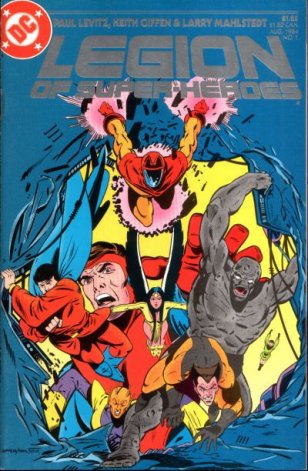 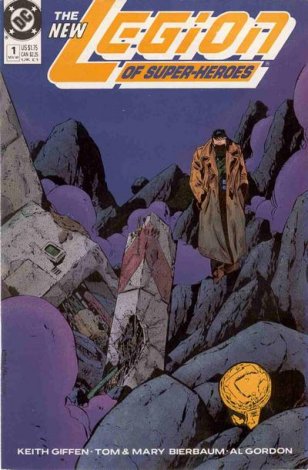
|
|
The Legion got a new launch in 1984, but its readership was now literally divided over two markets (newsstands and comic book stores), and when the dust settled, only the direct market version survived. Five years later, Keith Giffen figuratively divided fans with his darker take on the Legion with yet another # 1 in 1989. © DC Comics.
|
|
|
The Zero Hour reboot in 1994 lasted for ten years, at which point it was decided to reboot the series again. During its run, it saw the Legion series cancelled due to low sales and restarted as just The Legion after two placeholder mini-series. Attempts to increase the sales of The Legion with the addition of the new Superboy were ultimately considered a failure, which led to the second reboot of the franchise in a decade. After just over two years, creators Mark Waid and Barry Kitson left the newly-restarted Legion of Super-Heroes series, and were replaced by the return of Jim Shooter for his third run with the Legionnaires.
|
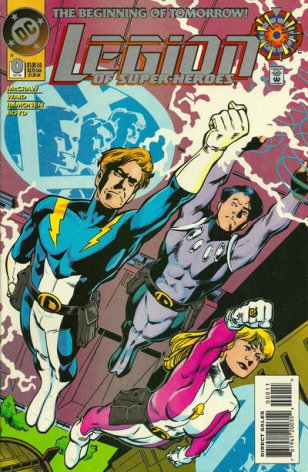 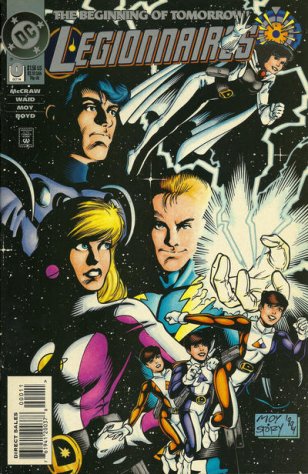
|
|
The "zero" covers of both Legion titles as the franchise was rebooted in the wake of Zero Hour. Stuart Immonen & Ron Boyd are the artists on the left, and Jeffrey Moy & Karl Story are the artists on the right. © DC Comics.
|
|

| | |
The Legion received another # 1 in 2001, this time without "of Super-Heroes" attached to the title. Cover artwork is by Olivier Copiel and Andy Lanning, the latter of which was also one of the series' co-authors. © DC Comics.
|
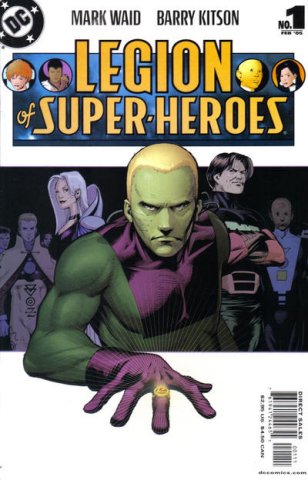 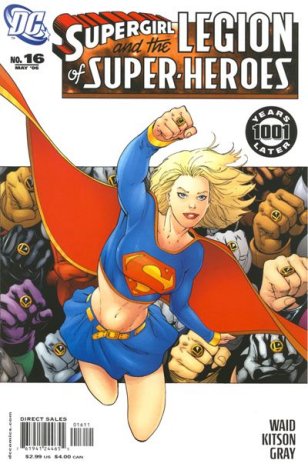
|
|
2005 saw the second Legion reboot, with the restoration of the full Legion of Super-Heroes title. One year later, Supergirl was added to the series, and the title was changed to reflect that fact. Cover artwork by Barry Kitson. © DC Comics.
|
|
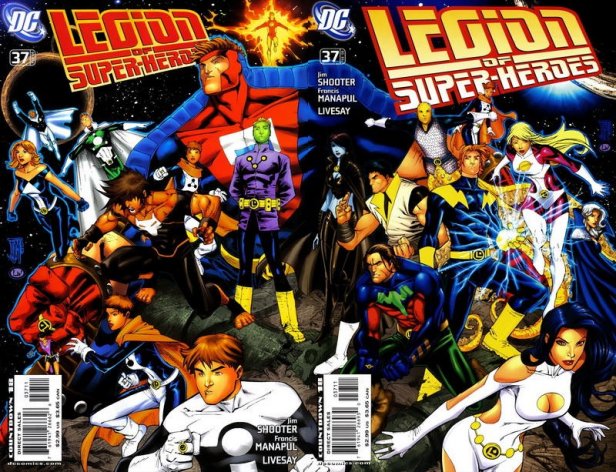
| | |
Jim Shooter returned to the Legion in 2008, a run that was doomed due to behind-the-scenes conflict and the resurgence of the original Legion of Super-Heroes in "The Lightning Saga." Cover artwork by Francis Manapul and John Livesay. © DC Comics.
|
|
It should also be noted that, simultaneous with the sale of the second Legion reboot series, authors Geoff Johns and Brad Meltzer, each the writer of Justice Society of America and Justice League of America, respectively, staged a crossover between their books which involved the return of the original Legion of Super-Heroes continuity. Called "The Lightning Saga," the story served as a prelude to the return of the original Legion of Super-Heroes in "Superman and the Legion of Super-Heroes" in Action Comics. The return of the Legion to Action was more than just a symbolic gesture, since the title was once the team's home; the first issue of the storyline sold out, and subsequent issues either sold more copies than their predecessors or held their own, sales-wise. At the conclusion of the storyline it was announced that Johns would be joined by George Perez on a Legion mini-series entitled Final Crisis: Legion of Three Worlds as part of DC's 2008 Final Crisis summer event. Johns has since expressed an interest in writing a continuing series featuring the original Legion continuity after the storyline concludes: whether or not his wish comes true is currently unknown.
|
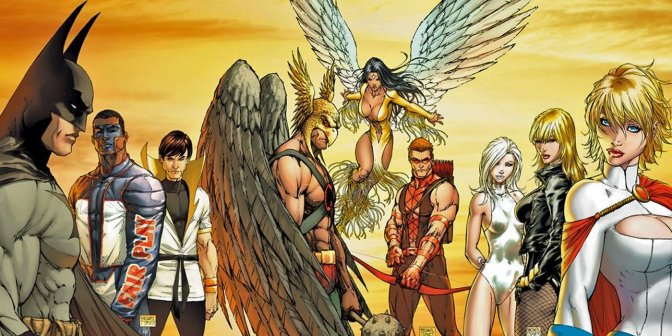
| | |
Michael Turner's artwork representing "The Lightning Saga." It was originally published as three separate Justice League of America covers. © DC Comics.
|
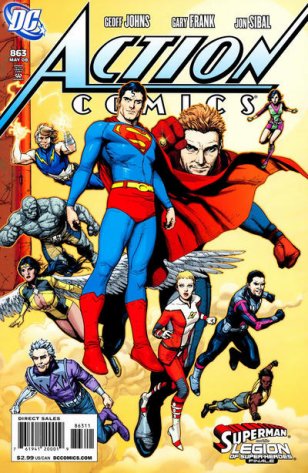 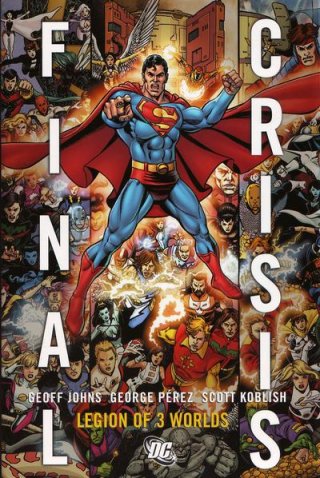
|
|
The return of Superman to the Legion mythos started in "The Lightning Saga," then continued into the pages of Action Comics, where the Legion had previously been tenants. Later that year (2008), Geoff Johns continued his non-Legion run with Final Crisis: Legion of Three Worlds. Gary Frank is the artist on the left; George Perez is the artist on the right. © DC Comics.
|
|
|
Also worth mentioning is the existence of the Legion cartoon which debuted on the CW Network in 2007. Although it only lasted for two seasons, it brought the Legion before its largest audience yet, and future generations of Legion fans whose first exposure to the team was on television have yet to be accounted for.
|
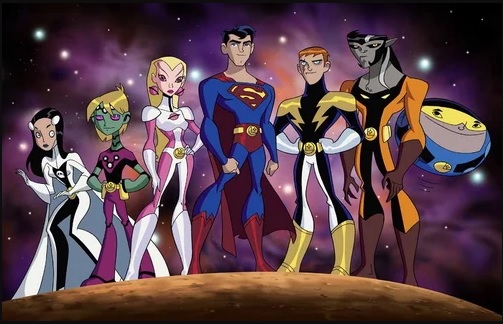
| | |
Promotional piece for the Legion of Super-Heroes cartoon that aired as part of the "Kids' WB!" block of Saturday morning programming. When the block was cancelled, the cartoon was cancelled with it, despite positive ratings. © Warner Brothers.
|
|
Over the past fifty years, writers and artists, editors and readers have journeyed to the 30th and 31st Centuries together, and they have seen a future that represents both the best and the worst that mankind has to offer. Back in the present (or is it the past?), the Legion of Super-Heroes has had its own best and worst times, both critically and commercially, yet it has endured for half a century. The appeal of the Legion, according to some, is self-evident: if it has to be explained to you, then you probably won't understand it. As readers, both long-time and recent, may attest, there are many who do, and as long as they continue to support their super-heroes, the odds of the Legion continuing to be published well into an uncertain future appear to be a certainty.
Glen Cadigan is the author/editor of The Legion Companion and The Best of The Legion Outpost, both published by TwoMorrows Publishing. He is also the author/editor of The Titans Companion and The Titans Companion Volume 2, both also published by TwoMorrows Publishing.
|
|
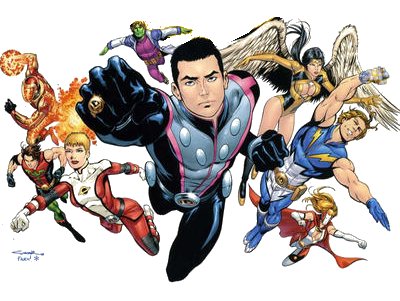
| |
The Legion of Super-Heroes by Yildiray Cinar & Wayne Faucher. © DC Comics.
|
|
[UPDATE: Since this article was published, Final Crisis: Legion of Three Worlds was released, followed by the return of Paul Levitz as Legion writer in 2010. The Legion first returned as a back-up feature in the relaunched Adventure Comics (the then-current Superboy was the lead), then became the lead feature itself (sound familiar?). Geoff Johns wrote both halves of Adventure, then handed the Legion off to Paul Levitz, who continued on at the Adventure helm. Levitz also received a brand new Legion # 1 concurrent with the decision.]
|
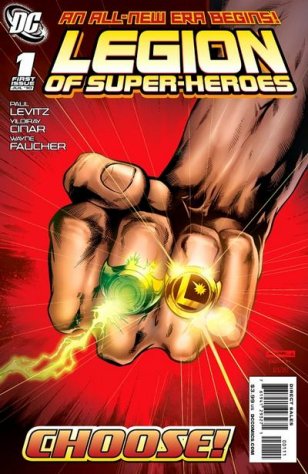 
|
|
Dubbed the "Retroboot" by fans, the original Legion of Super-Heroes received its own title again after returning in "The Lightning Saga," "Superman & The Legion of Super-Heroes," and Final Crisis: Legion of Three Worlds, plus back-up appearances in Adventure Comics, where they would ultimately, once again, be the lead. Covers by Yildiray Cinar & Wayne Faucher, and Scott Clark & David Beaty, respectively. © DC Comics.
|
|
|
[As part of DC's line-wide soft boot called "The New 52," the Legion was restarted at No. 1 again in 2011. It was joined by a second monthly Legion title, called Legion Lost, to replace the recently recancelled Adventure Comics.]
|
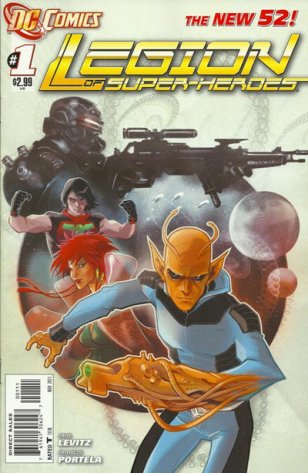 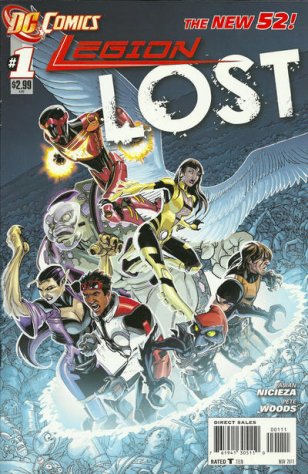
|
|
"The New 52" necessitated a new # 1 for The Legion of Super-Heroes, plus a companion title that resurrected the Legion Lost trademark from the first reboot era. The cover on the left is by Karl Kerschl, the one on the right is by Pete Woods. © DC Comics.
|
|
|
[Both books ran for two years, ceasing publication in 2013. But before they did, they were joined by the mini-series Star Trek/Legion of Super-Heroes (co-published with IDW) and Legion: Secret Origin, in which Paul Levitz told an updated version of how the Legion came to be. All four titles overlapped for a four month stretch from December 2011 - March 2012, effectively meaning that there was a new Legion comic every week.]
|
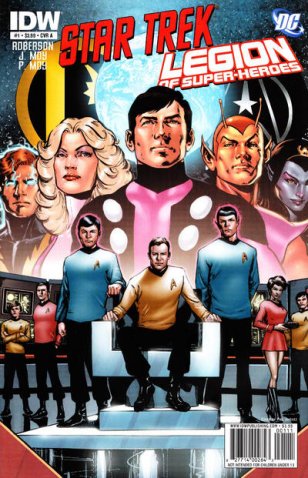 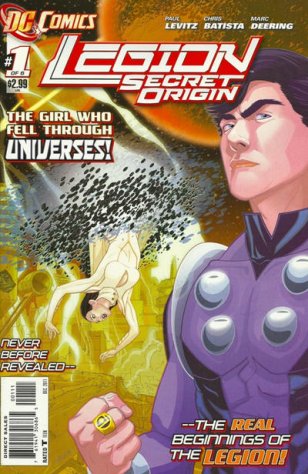
|
|
On the left, two science-fiction franchises meet, with cover art by Phil Jimenez. On the right, the Legion's origin is told (again), with cover art by Tom Feister. Legion of Super-Heroes © DC Comics; Star Trek © ViacomCBS.
|
|
|
[From 2013-2019, there was no ongoing Legion of Super-Heroes title. Whenever the Legionnaires appeared, they were guest-stars in other series until the franchise was rebooted yet again in 2019, following the events of the maxi-series, Doomsday Clock. That version of The Legion of Super-Heroes was written by Brian Michael Bendis and illustrated by Ryan Sook.]
|
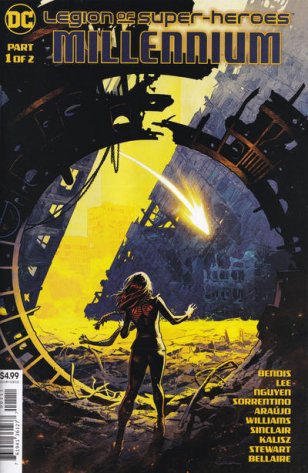 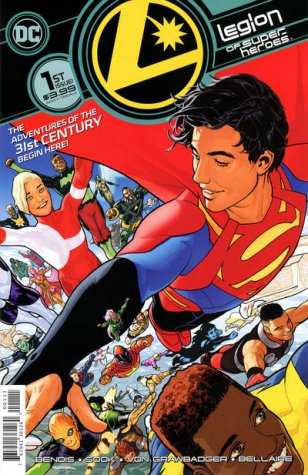
|
|
The 2019 version of the Legion of Super-Heroes, as depicted by Ryan Sook. © DC Comics.
|
|

|
|
|
|
|